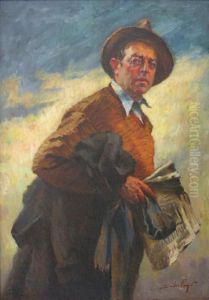Sandor Vago Paintings
Sándor Vágó, also known as Alexander Vago, was a Hungarian artist born in 1899, renowned for his contributions to the modernist movement. His work spanned various mediums, including painting, graphic design, and sculpture, reflecting the dynamic cultural changes of the early 20th century.
Vágó's early life and education took place against the backdrop of a Hungary that was experiencing its own artistic renaissance. Growing up in Budapest, Vágó was exposed to a city that was rapidly modernizing and becoming a cultural hub within the Austro-Hungarian Empire. This environment undoubtedly influenced his artistic development.
He studied at the Hungarian College of Fine Arts under the tutelage of renowned artists of the time. However, his career was not just confined to Hungary. The interwar period was a time of great mobility and exchange among European artists, and Vágó was part of this internationalist wave. He traveled to Germany and France, where he was exposed to the avant-garde movements of the era, including Expressionism, Cubism, and later, Surrealism.
In his work, Vágó sought to capture the essence of his subjects through a modernist lens, often focusing on the human figure, landscapes, and still lifes. His style evolved over the years, but he consistently exhibited a bold use of color and a tendency to distill forms to their essentials, reflecting the influence of his contemporaries and the broader modernist movement.
Despite his talent and contribution to Hungarian modernism, Vágó's life and career were cut short by the geopolitical upheavals of the mid-20th century. World War II and the Holocaust had a profound impact on Hungary and its Jewish population, of which Vágó was a part. These events would overshadow his later years and ultimately lead to his untimely death in 1946.
Today, Sándor Vágó's work is recognized for its place in the canon of Hungarian art and its representation of European modernism. His pieces can be found in Hungarian museums and are appreciated by art historians and collectors who have a keen interest in the period and its artists.



